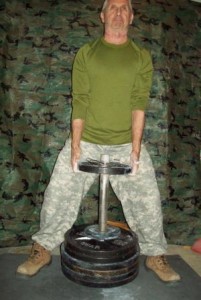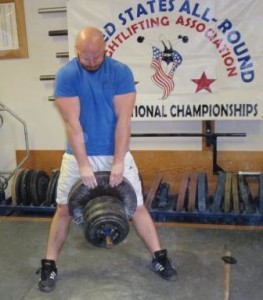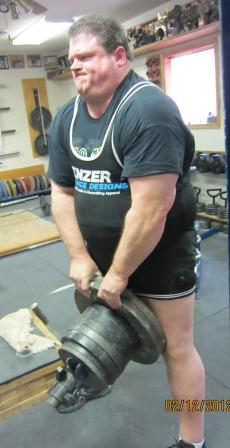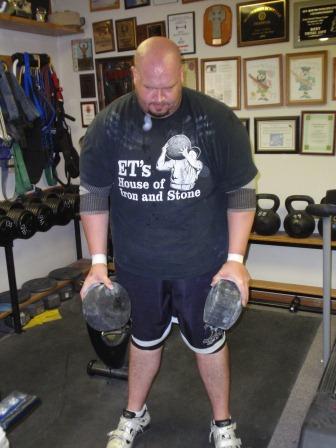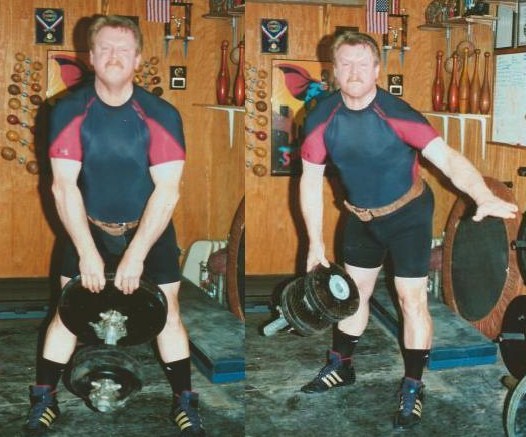The New Pinch Grip
By Al Myers
At the Annual General Meeting of the USAWA one of the big lift changes that was made has been with the rules for the Pinch Grip. Let me give a little back story here on this lift. The Pinch Grip has been an official lift of the USAWA/IAWA for a long time. The intent of the lift is to test the grip by pinching two plates together and lifting the plates with added weight. The original rule was pretty vague in the technical aspects of the rules – probably because it seemed like a lift that should be pretty self-explanatory. However, a few years ago many lifters starting performing the Pinch Grip with added fronthang as the rules didn’t prevent it. Because of this the Pinch Grip rule was amended to allow fronthang and/or backhang as that was the way it was being done. Fronthang is an obvious advantage as it allows the gripping plates to tip placing more of the gripping pressure on the fingers instead of the thumb which allows more weight to be lifted.
The Pinch Grip was a lift in this years USAWA Grip Championships. The deficiency of the Pinch Grip rules were very much exposed in this meet. Now instead of fronthang plates being placed tight together, the added weight started to be spaced out towards the end of the bar creating even more fronthang. It got to the point that the lifting plates were being lifted horizontal to the platform! I was the head official of this meet and there wasn’t anything I could say because the execution of these lifts were being done according to the written rule for the Pinch Grip. I am in NO WAY saying what was being done was wrong in any way as it was being done by the rules, despite not really being in the original intent of the Pinch Grip, and definitely not how the Pinch Grip had been performed in the past.
So at the AGM (after being presented, evaluated and passed by the Executive Board) I presented the new Strict Pinch Grip as well as a Pinch Grip Deadlift, which is pretty much the previous rule for the Pinch Grip. Both lifts passed the membership vote by unanimous vote. The current records in the Pinch Grip will be moved to the Pinch Grip Deadlift and a new record list will be established for the Strict Pinch Grip. This way no records will be lost. Any past competition that was done using the strict Pinch Grip Rules will be “grandfathered” into the new record list for the Strict Pinch Grip (I know of several in the past that are eligible). And finally, I do apologize on behalf of myself and the USAWA to all lifters that were adversely affected by this at the Grip Championships. And to make up to everyone – both the Pinch Grip Deadlift AND the Strict Pinch Grip will be done at next year’s Grip Championship.
These are the new rules for the Pinch Grip Deadlift and the Pinch Grip – Strict.
Pinch Grip Deadlift
The setup for this lift requires two metal plates joined together with smooth surfaces facing outward which will be referred to as the lifting plates. Any diameter of lifting plates may be used. A vertical bar is placed between the plates to hold them together, and should be long enough to add plates to it. It is recommended that the lifting plates are secured together. Maximum length of the apparatus is 18 inches. The lifter’s fingers must not touch any added plates or the vertical bar. The width of the two lifting plates joined together must be between 2 ¼ inches and 2 ½ inches. The lifter will straddle the weight, with the weight being placed in front of the lifter standing upright with the lifting plates horizontal to the platform. Width of feet placement is optional, but the feet must be parallel and in line with the torso. Feet must not move during the lift, but the heels and toes may rise. The lifter will then grip the lifting plates with both hands. The fingers must be placed under the lifting plates with the thumb touching the lifting plates on the top. The lift begins at the lifter’s discretion. The weight must be lifted to a point where the lifter’s legs are straight and the body upright. The lifting plates may touch the lifters body during the lift but must not be braced against the body during the lift to aid in the lift. Once the weight is motionless, an official will give a command to lower the weight.
Pinch Grip Deadlift – One Hand
The rules of the Pinch Grip Deadlift apply except only one hand is used. The non-lifting hand may be braced against the legs or body during the lift, but must be free from the body upon completion of the lift.
Pinch Grip – Strict
The setup for this lift requires two metal plates joined together with smooth surfaces facing outward. A bar may be placed between the plates to hold them together, and should be long enough to add plates to it. Front hang or back hang is NOT allowed. The added weight plates must be evenly loaded with no gaps between any plates, including the lifting plates. Collars should be used on this bar to keep added weight plates from moving. The lifter’s fingers must not touch any added plates or the lifting bar. The width of the two plates joined together must be between 2 ¼ inches and 2 ½ inches. Any diameter plates may be used as the lifting plates. The lifter will straddle the weight, with the weight being placed in front of the lifter. Width of feet placement is optional, but the feet must be parallel and in line with the torso. Feet must not move during the lift, but the heels and toes may rise. The lifter will then grip the plates with both hands on the top of both plates. The palms of the hands must be facing the lifter. The lift begins at the lifter’s discretion. The weight must be lifted to a point where the lifter’s legs are straight and the body upright. During the lift the plates must be maintained perpendicular to the platform. Once the weight is motionless, an official will give a command to lower the weight.
Pinch Grip – Strict, One Hand
The rules of the Pinch Grip – Strict apply except only one hand is used. The non-lifting hand may be braced against the legs or body during the lift, but must be free from the body upon completion of the lift.
